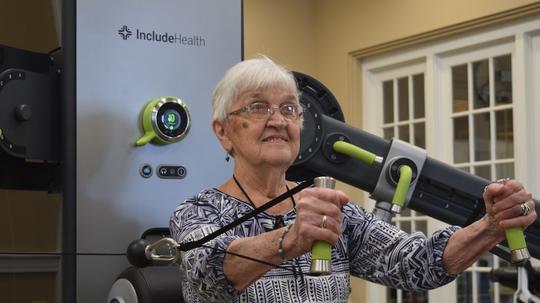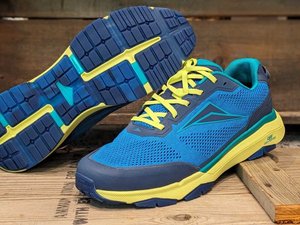
While the accessible fitness equipment that initially sparked IncludeHealth (formerly IncludeFitness) was conceptualized in 2006, the company celebrated its commercial launch of their inclusive digital health and wellness platform in early 2018 after years of analyzing, designing and reimagining care.
After founder Ryan Eder saw a man in a wheelchair struggle to use fitness equipment in the gym, Eder saw the need for fitness equipment that accommodates people of all ages and abilities and was inspired to originally design The Access Strength, an accessible functional trainer that delivers hundreds of upper body and lower body exercises on one machine.
Eder developed The Access Strength as his senior thesis while studying industrial design from the College of Design Architecture Art & Planning at the University of Cincinnati. The machine was designed to provide versatility while removing barriers that prevent many demographics from using exercise equipment and staying healthy.
“We make sure that you can use it standing, seated or in a wheelchair — we’ve also removed all the need for dexterity,” Eder said.
The Access Strength went on to win Best In Show at the 2007 International Design Excellence Awards, singled out of 1,700 entries from 35 countries. For context, subsequent years’ winners include Apple, Microsoft, Nike and Tesla. However, it would still take some time before the company could successfully launch. Eder worked full time as a designer for PriorityDesigns in Columbus while he moonlighted as leader at IncludeFitness on evenings and weekends and collaborated with UC’s Mechanical Engineering department for two years to build the first prototypes of the machine.
“It’s not just about collecting data and delivering data, but it’s doing it in an inclusive and engaging way so all demographics can and will benefit from this technology."
At the time, the company focused solely on accessible fitness equipment. Once the first pre-production unit was created in 2013, Eder took the machine on tour in their mobile showroom and saw that a wide variety of people were able to use The Access Strength, such as quadruple amputees who were able to adjust the machine using only their elbows. However, once physical accessibility seemed solved, he then started to think about cognitive accessibility.
He wondered, “Now that you have a machine that everyone can use, how to you know what to do, how to do it, and keep track of things?”
Software coupled with the equipment was the answer. The next step was embarking on another round of funding.
IncludeHealth has had success in that regard, having received support from various Ohio institutions — like CincyTech, Linkage, Queen City Angels, Accelerant, The Ohio TechAngel Fund, Connetic Ventures, Vine St. Ventures, the Cherub Fund and numerous individuals. In addition to this testament of community support, The Access Strength is manufactured by TSS Technologies in West Chester.
IncludeHealth also involved a wide variety of experts for collaboration, like athletic trainers, physical therapists, physicians and payers in the physical rehabilitation landscape, as it grew and developed its software.
“My whole philosophy from a design and creation perspective is to collaborate,” Eder said. “I don’t have all the answers, I simply like to work with thought leaders and connect the dots.”
This insight gleaned from these professionals continued to galvanized Eder and company in their software development pursuit.
“Through that process, we realized there was a larger opportunity to transform an industry through technology," Eder said. "It was then that we evolved from an accessible piece of fitness equipment to an inclusive and integrated digital health and wellness platform. Our goals expanded from just [making the space inclusive] to also digitizing it."
The software, known as The IncludeCloud, is a HIPAA-compliant and cloud-based web application that integrates with The Access Strength. Both providers and patients may open an account and access libraries of downloadable exercises that can be built upon. Providers can assign protocols to patients, who can utilize a RFID tag on the equipment to access their profile and instructions for the workout. Providers can also set parameters such as weight and range of motion, as well as view detailed metrics that the equipment records while in use, such as velocity, force, power, tempo, range of motion and symmetry. After a workout, patients and practitioners can both view the data, which practitioners can then analyze, use to generate reports, submit directly for billing and more.
“The objective outcomes-based data our system produces can provide deep insights to improve care. It is meant to provide extremely granular detail on individual progress while also aggregating data to explore macro trends and develop normative data sets in a way that is meaningful for both the providers and the patients,” Eder said. “It’s not just about collecting data and delivering data, but it’s doing it in an inclusive and engaging way so all demographics can and will benefit from this technology."
In 2016, Eder publicly debuted the evolution of his concept and decided to re-enter it in The International Design Excellence Awards. Not sure if he would be disqualified due his prior win, The Include Platform was recognized once again with Gold and Best in Show. Their technology is now recognized with 28 innovation and health awards.
With the evolution of IncludeHealth's technology, they realized that their platform was applicable in not just fitness, but also across the entire continuum of care. Previously operating as IncludeFitness, he felt their brand needed to follow suit, rebranding the company to IncludeHealth in 2017.
“IncludeHealth reflects both our origin and our expanded vision to transform lives and industries through technology, data and inclusive design."
With the new rebrand, IncludeHealth officially commercialized in the first quarter of 2018. The Include Platform is currently in use by Cleveland VA Medical Center, HeathPartners Neuroscience Center in Minneapolis, Christian Village Communities in Mason,Dayton Children’s Hospital, Mercy Health, and The Ohio State Medical Center with more systems shipping soon.
Eder said the company has built a powerful foundation with key technology and partners, and plans to continue IncludeHealth’s mission of improving lives through technology and design.
"This is just the tip of the iceberg," he added.








